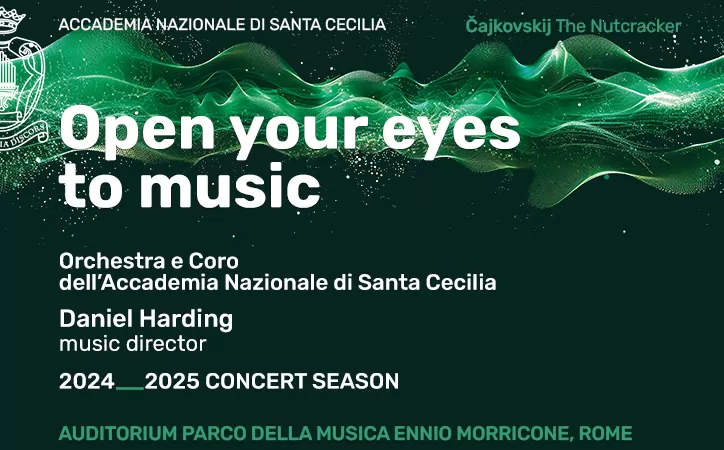The Archaeological Park of Pompeii, open again after a three-month lockdown due to covid-19, has seen a remarkable reversal of fortunes over the last decade.
Pompeii was the first Italian archaeological site to reopen to the public after the coronavirus shutdown. The first visitors after the three-month closure were welcomed on 26 May, with initial access only through the Amphitheatre entrance for small groups following strict one-way itineraries.
Since 9 June the rules have relaxed somewhat, with the popular Porta Marina entrance now operative as well and a choice of routes to follow, taking in many of the most celebrated and interesting features.
Opening Pompeii was considered a priority for Italy's tourism industry. In 2019 the site welcomed some four million visitors, and it is Italy's third most popular attraction after the Colosseum in Rome and the Uffizi in Florence.
“Restoration and maintenance have continued throughout the closure to guarantee visitor safety and site protection,” declared Pompeii's outgoing director general Massimo Osanna in his opening announcement, when he also recommended a new visitor approach: “a Pompeii to be enjoyed without rushing.”
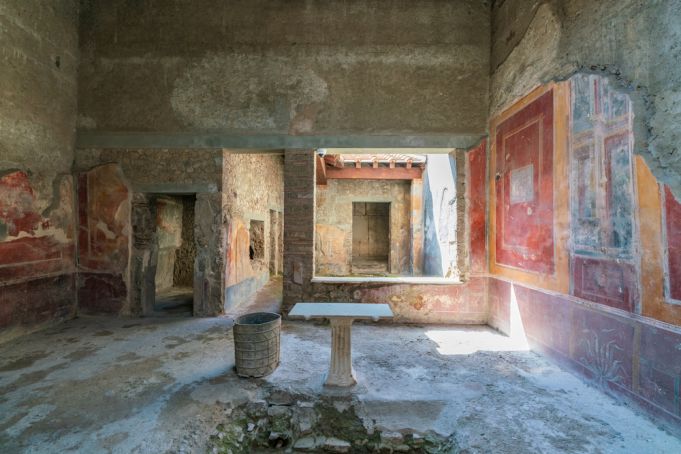
These include the sumptuous estate of property owner Julia Felix, who rented out apartments on her property, complete with baths and leisure gardens for public use, the elegant peristyled garden of the House of the Golden Cupids, the relaxing garden of the House of Octavius Quartio with a pool among the vines and the newly re-opened palatial home of Cornelius Rufus with its marble impluvium, columned garden and fountain.
Other “green spaces” on the route include the lawns of the Large Palaestra (gymnasium), the Necropolis of Porta Nocera and the melancholy Garden of the Fugitives, a vineyard where the remains of 13 people were discovered buried under a thick layer of volcanic ash and cinders.
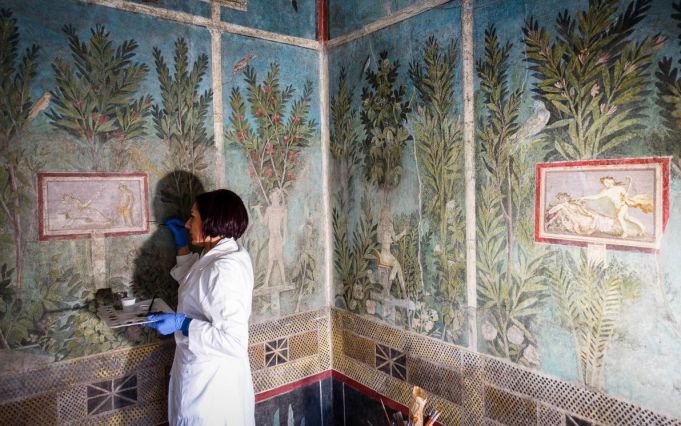
New “treats” to be seen include the House of Leda and the Swan with the erotic fresco that caused a sensation when it was discovered in 2018, and the recently-opened House of the Ship Europa, so called because of a sketch of a Roman merchant ship scratched out in the plaster of one of the walls. The ship is surrounded by a number of smaller boats and has the name “Europa” written on the prow. Naturally, this does not have the meaning it would have nowadays.In Ancient Roman times, the notion of Europe as a continent did not exist. Greek geographers used the term to refer to an area of the Balkans, now split between Bulgaria, Greece and Turkey. It wasn't until the eighth century (AD) that the name came to be used to identify Charlemagne's empire, thus ensuring the immortality of the mythical Phoenician princess Europa, who was abducted and carried off to Crete by Zeus, the father of the gods, in the guise of a bull.
The House of the Ship Europa was added to the long list of Pompeii sights only in January this year, along with several other important domus that had been closed for years. These include authentic jewels of interior decoration like the House of the Orchard (Casa del Frutteto), where researchers were stunned to find that the brilliant colours of the wall paintings were still well preserved after being buried for almost 2,000 years.
The harmonious interior garden of the house seems to blend into the surrounding rooms, which are covered in paintings of trees, birds and flowers, rather in the style of the famous “painted garden” from the triclinium of Livia's house on display in the Palazzo Massimo alle Terme Museum in Rome. The central focus of the frescos is intriguing: it depicts a giant fig tree with a snake twined around its trunk.
Experts interpret this as a simple augury of prosperity but the fact that some of the adjoining rooms are decorated with Egyptian motives indicates that the family who lived there were probably followers of the Nile goddess Iside, whose cult was very popular in first-century Rome.
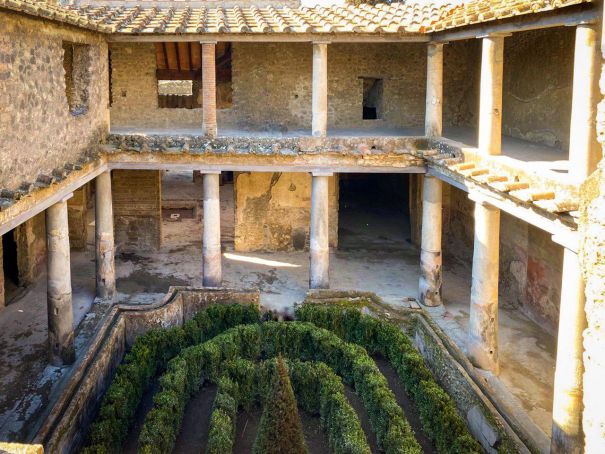
The nearby House of the Lovers (Casa degli Amanti) got its name thanks to a poem inscribed on the wall comparing the sweetness of lovers' lives to that of honey bees. However, what really sets it apart is the fact that the second storey of the peristyle round the interior garden is practically intact – an architectural feature believed to be unique in Pompeii. Jolly scenes of people partying decorate the walls of the rooms, giving an impression of the lighthearted and comfortable lifestyle enjoyed by the wealthy inhabitants before the deadly eruption that blotted out their existence.
Some of the citizens were so rich that they could indulge in vast banquets, like that involving 6,840 guests, as recorded on an inscription in a tomb discovered in 2017. The lavish party was organised to celebrate the coming-of-age of the son of the house. According to the inscription, deciphered by Massimo Osanna, the arrangements required 456 three-sided couches where the diners could lounge. The host also provided entertainment on a suitable scale with 416 gladiator contests, a show that must have lasted several days.
There is evidence, however, that not all the wealthy were totally self-centred. A fresco now in the Archaeological Museum of Naples shows a toga-robed dignitary distributing bread to the needy, possibly at the time when a famine hit the area.These new discoveries have come about thanks to the Great Pompeii Project, launched with EU support in 2012 and brought to conclusion at the beginning of this year. The project aimed at the re-qualification of the site, with a princely grant of €105 million, 75 per cent of which was put up by the EU and the rest by the Italian government. The project wound up within budget, with €92 million spent as per the 30 January 2020 deadline. “The extraordinary results obtained are a motive of pride for Italy,” declared Dario Franceschini, Italian minister of heritage, culture and tourism.
The greatest share of the money has been used to make the site safe by shoring up and consolidating damaged or unsteady walls, as well as stabilizing 45 buildings that were at risk. These included important monuments such as the temple of the Egyptian goddess Isis, the public baths, the Odeon (or small theatre) and numerous private domus, many decorated with artistic frescoes.
Work has involved the removal of 30,000 cubic metres of lapilli, cinders and earth and a resulting cache of 1,167 boxes and 168 packing cases full of antiquities. The working teams included a range of specialists such as archaeologists, architects, restorers, geologists, anthropologists, engineers, volcanologists, palaeobotanists and zoo-archaeologists.
The project allowed archaeologists to explore hitherto neglected and inaccessible zones, such as a 2,000-sqm triangular wedge in the Regio V area in the northern side of the park. One of the most sensational finds that they brought to light was a realistic wall painting of a gory gladiator combat in what had probably been a tavern with a brothel upstairs. More tragic discoveries included the skeleton of a fugitive with his chest crushed under a huge fallen rock. He was holding a purse containing his savings of silver coins. The remains of a horse also emerged, as well as the huddled skeletons of two women and three children.
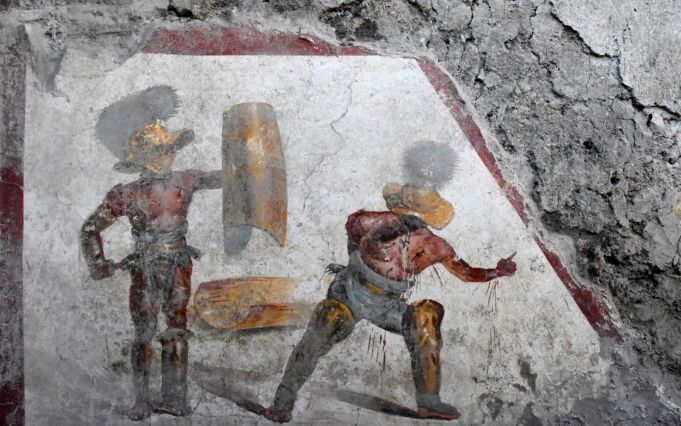
Going round the impeccably kept archaeological site of Pompeii today, it seems impossible to believe that less than ten years ago it was suffering a progressive and seemingly irreversible decline. Many of the most famous buildings were declared unsafe and inaccessible. Whole areas of the city were off limits. Personnel was scarce and surveillance virtually non-existent. Stray dogs wandered freely around ruins smothered in undergrowth. Lightning strikes by disgruntled custodians left lines of protesting tourists locked outside closed gates.In 2010 heavy rainfall and lack of proper drainage brought down a series of walls. The total collapse of a celebrated building identified as the Schola Armaturarum (the house, or barracks, of the gladiators) on the Via dell'Abbondanza main artery, caused an outcry in the international press. At that time, incredibly, only ten buildings were open to the public and only 13 per cent of the excavated area was accessible.
Throughout the next few years Pompeii continued to crumble while experts struggled with insufficient funding to halt the decay and UNESCO threatened to place the archaeological park in its black list of endangered world heritage sites.
Thanks to the success of the Grand Pompeii Project, the situation has been totally reversed. Despite some restrictions, imposed for safety measures during the present pandemic, visitors today can look forward to an enjoyable tour round the paved streets, past the poignant remains of long-ago Roman businesses, eateries, spas, public buildings and cult centres, with privileged peeps into the homes and gardens of the upper classes.The Pompeii site may seem huge enough to get round today, but only about a third of the original city has actually been excavated. Future excavations may push the site's history even further back. Under the Roman overlayer lie intriguing traces of a history that indicate even older origins. During the recent excavations near the Herculanum Gate, a tomb dating back to the fourth century BC was discovered. It belonged to a high ranking Samnite woman buried with a rich cache of funerary goods. Archaeologists believe that they will eventually be able to burrow down to the very origins of Pompeii, to the Oscan culture of seventh-sixth century BC and before that, the Greeks and the Etruscans.
However, the real challenge, according to culture minister Dario Franceschini, “lies in the conservation and preservation of what we already have.”
Pompeii is unique, but it is also fragile and vulnerable. The goals achieved with the Great Pompeii Project must be maintained if future generations are to continue to enjoy the art, the mystery and the insights into long-ago lives that this precious and unequalled archaeological site offers.
By Margaret Stenhouse
Visiting information: Prior booking obligatory online through the TicketOne website where visitors can choose their preferred time slot. Entry allowed every 15 minutes for a maximum 40 people at a time. Visitors are allowed to carry only one small bag. Safety measures in place include temperature checks at the entrance, hand sanitisers at the gates and toilets, the wearing of masks throughout the visit and maintaining social distancing. For full visiting details see website.
This article was published in the July-August 2020 online edition of Wanted in Rome magazine.
General Info
View on Map
Pompeii unveils new hidden secrets
Via Villa dei Misteri, 2, 80045 Pompei NA, Italy


